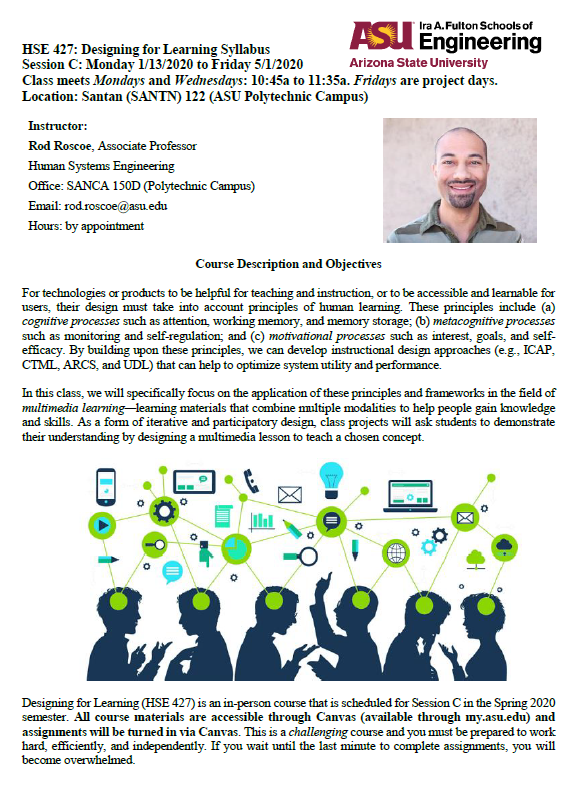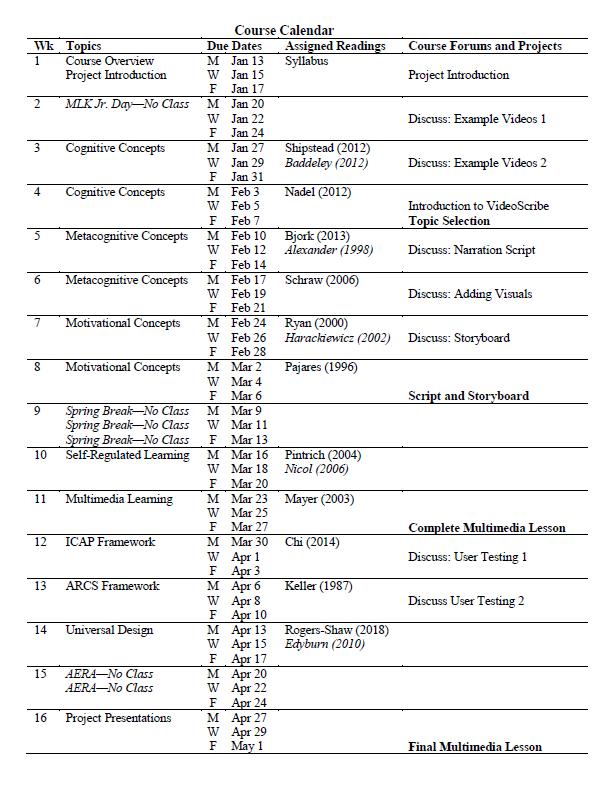HSE 427: Designing for Learning
For technologies or products to be helpful for teaching and instruction, or to be accessible and learnable for users, their design must take into account principles of human learning. These principles include (a) cognitive processes such as attention, working memory, and memory storage; (b) metacognitive processes such as monitoring and self-regulation; and (c) motivational processes such as interest, goals, and self-efficacy. By building upon these principles, we can develop instructional design approaches (e.g., ICAP, CTML, ARCS, and UDL) that can help to optimize system utility and performance.
HSE 427 focuses on the application of these principles and frameworks in multimedia learning—learning materials that combine multiple modalities to help people gain knowledge and skills. As a form of iterative and participatory design, class projects ask students to demonstrate their understanding by designing a multimedia lesson to teach a chosen concept. Over the semester, students follow procedures that are similar to how the Human Systems Engineering Education research team develops their videos (see Brainstorming, Creativity, Empathy, and Attitudes example lessons).
This process also incorporates the Entrepreneurial Mindset as an accessible instructional design approach. Students are encouraged to consider how their lessons can inspire curiosity about the topics, help viewers form connections with the information, and help viewers create value via concrete strategies.
Design Process Summary
Step 1: Review of existing examples
-
- review prior materials to become familiar with existing content
- consider how to incorporate mindful links across lessons without duplication or redundancy
- attend to style and design elements to maintain consistency
Step 2: Consult relevant empirical sources and guides for best practices
-
- lessons should not overwhelm viewers with citations and quotes
- however, informational content should be informed by research and expert practice
- developers should be able to provide these justifications on demand
Step 3: Develop the content narration script
-
- the script includes the informational content that will be provided to viewers
- focus on clear and accessible language; avoid unnecessary jargon or technical terms
- essential concepts and terms should be clearly defined when introduced
- an uninterrupted “read aloud” of the script should be used to refine timing
Step 4: Identify and develop visual elements
-
- visual elements should illustrate, emphasize, and reinforce script content
- visual elements include both graphics and any on-screen text (e.g., bullet points)
- visual presentation should be able to communicate all content even without the narration
- images should be Creative Commons, license-free, and obtained legally
Step 5: Develop integrated storyboard
-
- script should include notes regarding pacing, pausing, and integration with visual elements
- storyboard should be clear about when visual elements are presented
- script and visuals should provide complete and coherent content on their own
- however, integrated script and visuals should provide rich learning materials
Step 6: Produce complete multimedia lesson prototype
-
- functional prototype should be viewable and navigable as a video (e.g., play, pause, etc.)
- prototype must include both narration and visuals
Step 7: Iterative user testing and evaluations
-
- user testing invites participants (similar to end-users) to view the video lessons
- users reflect on what was learned, memorable, enjoyable, frustrating, and so on
- developers observe users’ behaviors, errors, and non-verbal cues during viewing
- developers create and prioritize a list of revisions
Step 8: Produce finalized multimedia lesson
-
- complete (at least) two rounds of iterative testing
- implement revisions for script content, visual components, pacing, and other design elements
- record final narration and integrate with final visual presentation
Example syllabus materials (description and calendar) from the Spring 2020 iteration of HSE 427: Designing for Learning. These materials are updated each year and may not represent future versions of the class.


